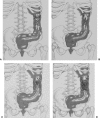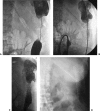Colon stenting: a review
- PMID: 21331130
- PMCID: PMC3036228
- DOI: 10.1055/s-2004-860941
Colon stenting: a review
Abstract
Up to 85% of patients who present with colonic obstruction have a colorectal cancer. Between 7% and 29% of these patients present with total or partial intestinal obstruction. Only 20% of these patients presenting with acute colonic obstruction due to malignancy survive 5 years. Emergent surgical intervention in patients with colonic obstruction is associated with significant morbidity and mortality rates. Only 40% of patients with obstructive carcinoma of the left colon can be treated with surgical resection without the need for a colostomy. The use of a temporary or permanent colostomy has a significant impact on quality of life. The decompressive effect seen with colonic stenting is a durable, simple, and effective palliative treatment of patients with advanced disease. Stent deployment provides an effective solution to acute colonic obstruction and allows surgical treatment of the patient in an elective and more favorable condition. In addition, colonic stenting reduces costs and avoids the need for a colostomy.
Keywords: Colon cancer; colonic stenting; intestinal obstruction.
Figures
















References
-
- Boyle P, Leon M. Epidemiology of colorectal cancer. Br Med Bull. 2002;64:1–25. - PubMed
-
- Deans G T, Krukowski Z H, Irwin S T. Malignant obstruction of the left colon. Br J Surg. 1994;81:1270–1276. - PubMed
-
- Duxbury M, Brodribb A, Oppong F, Hosie K. Management of colorectal cancer: variations in practice in one hospital. Eur J Surg Oncol. 2003;29:400–402. - PubMed
-
- Griffith R. Prospective medical obstacles to surgery. Cancer. 1992;70:1333–1341. - PubMed
-
- Smothers L, Hynan L, Fleming J, Turnage R, Simmang C, Anthony T. Emergency surgery for colon carcinoma. Dis Colon Rectum. 2003;46:24–30. - PubMed

